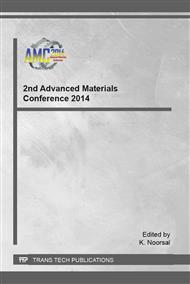[1]
Y. A El-Shekeil, S.M. Sapuan, K. Abdan, E.S. Zainudin, Influence of fiber content on the mechanical and thermal properties of Kenaf fiber reinforced thermoplastic polyurethane composites, Materials and Design. 40 (2012) 299-303.
DOI: 10.1016/j.matdes.2012.04.003
Google Scholar
[2]
A.R. Bunsell, J. Renard, Fundamentals of fibre reinforced composite materials, Institute of Physics Publishing, Bristol and Philadelphia, 2005, p.240.
Google Scholar
[3]
M.C. Symington, W.M. Banks, O.D. West, R.A. Pethrick, Tensile testing of cellulose based natural fibers for structural composite applications, Journal of Composite Materials. 43 (2009) 9.
DOI: 10.1177/0021998308097740
Google Scholar
[4]
S. Rassmann, R. Paskaramoorthy, R.H. Reid, Effect of resin system on the mechanical properties and water absorption of kenaf fibre reinforced laminates, Material and Design. 32 (2011) 1399-1406.
DOI: 10.1016/j.matdes.2010.09.006
Google Scholar
[5]
Z. Salleh, K.M. Hyie, M.N. Berhan, Y.M. Taib, M.K. Hassan, D.H. Isaac, Effect of low impact energy on kenaf composite and kenaf/fiberglass hybrid composite laminates, Applied Mechanics and Materials. 393 (2013) 228-233.
DOI: 10.4028/www.scientific.net/amm.393.228
Google Scholar
[6]
E. Osman, A. Vakhguelt, I. Sbarski, S. Mutasher, Mechanical properties of kenaf-unsaturated polyester composite: Effect of fiber treatment and fiber length, Advanced Materials Research. 311-313 (2011) 260-271.
DOI: 10.4028/www.scientific.net/amr.311-313.260
Google Scholar
[7]
M. Jawaid, H.P.S. Abdul Khalil, A.H. Bhat, A. Abu Bakar, Impact properties of natural fiber hybrid reinforced epoxy composites, Advanced Materials Research. 264-265 (2011) 688-693.
DOI: 10.4028/www.scientific.net/amr.264-265.688
Google Scholar
[8]
H.M. Akil, M.F. Omar, A.A.M. Mazuki, S. Safiee, Z.A.M. Ishak, A.A. Bakar, Kenaf fiber reinforced composites: A review, Materials and Design. 32 (2011) 4107-4121.
DOI: 10.1016/j.matdes.2011.04.008
Google Scholar
[9]
S. Nunna, P.R. Chandra, S. Shrivastava, A.K. Jalan, A review on mechanical behavior of natural fiber based hybrid composites, Journal of Reinforced Plastic and Composites. 31 (2012) 759-769.
DOI: 10.1177/0731684412444325
Google Scholar
[10]
P.K. Mallick, Fiber-Reinforced Composites Materials, Manufacturing and Design, 3rd Ed., Taylor & Francis Group, (2008).
Google Scholar
[11]
O.M.L. Asumani, R.G. Reid, R. Paskaramoorthy, The effects of alkali-treatment on the tensile and flexural properties of short fibre non-woven kenaf reinforced polypropylene composites, Composites. Part A. 43 (2012) 1431-1440.
DOI: 10.1016/j.compositesa.2012.04.007
Google Scholar
[12]
B.F. Yousif, A. Shalwan, C.W. Chin, K.C. Ming, Flexural properties of treated and untreated kenaf/epoxy composites, Materials and Design. 40 (2012) 378-385.
DOI: 10.1016/j.matdes.2012.04.017
Google Scholar
[13]
Y.A. El-Shekeil, S.M. Sapuan, K. Abdan, E.S. Zainudin, Influence of fiber content on the mechanical and thermal properties of Kenaf fiber reinforced thermoplastic polyurethane composites, Materials and Design. 40 (2012) 299-303.
DOI: 10.1016/j.matdes.2012.04.003
Google Scholar
[14]
A.R. Bunsell, J. Renard, Fundamentals of fibre reinforced composite materials, Institute of Physics Publishing, Bristol and Philadelphia, 2005, p.240.
Google Scholar
[15]
S. Rassmann, R. Paskaramoorthy, R.H. Reid, Effect of resin system on the mechanical properties and water absorption of kenaf fibre reinforced laminates, Material and Design. 32 (2011) 1399-1406.
DOI: 10.1016/j.matdes.2010.09.006
Google Scholar
[16]
A.M.M. Edeerozey, H.M. Akil, A.B. Azhar, M.I.Z. Ariffin, Chemical modification of kenaf fibers, Materials Letters. 61 (2007) 2023-(2025).
DOI: 10.1016/j.matlet.2006.08.006
Google Scholar
[17]
F.L. Matthews, R.D. Rawlings, Composite Materials: Engineering and Science, Woodhead Publishing Limited, Cambridge England, 2002, p.171.
Google Scholar


